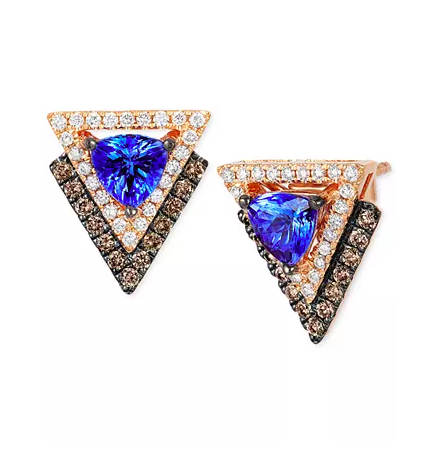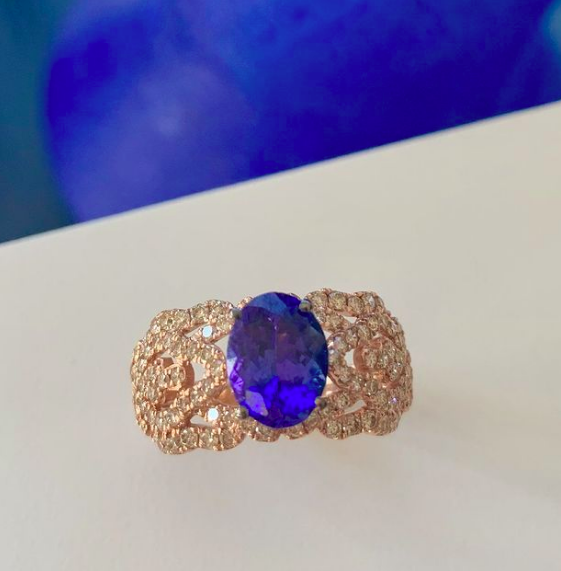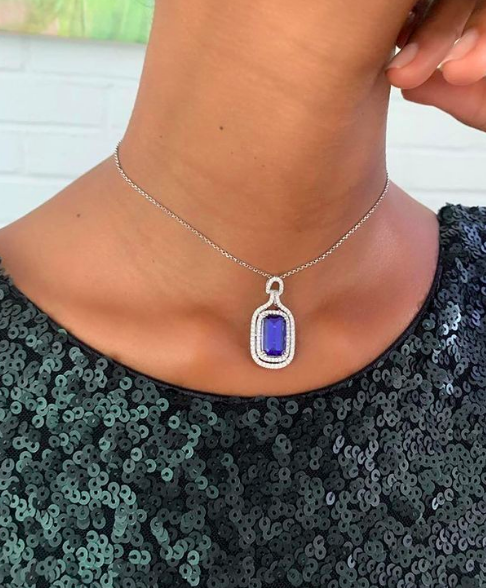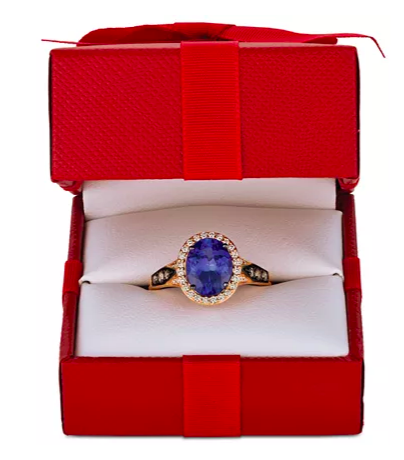Spotlight: Le Vian Blueberry Tanzanite®
Tanzanite, a relative newcomer to the gem world, is a deep blue-hued stone that is deserving of any elegant jewel lover’s attention. Much like the orange-pink beauty Morganite, tanzanite’s history is relatively limited, as it hasn’t even been around for a century, but has gained a cult following in the fine jewelry realm today.

Its story begins in 1967 in Merelani, an area in northern Tanzania in the foothills of Mount Kilimanjaro, according to the American Gemological Trade Association. After a fire caused by lightning, a Masai cattle herder came upon a cluster of violet blue crystals peeking out of the ground. The herder noticed that what was once a heap of brown crystals had now emerged as a glistening blue-violet mound.
Although the herder was unaware, the stone’s secret had been discovered. The heat of the fire had rendered this spectacular color change. When exposed to heat, this stone’s dull pink, purple, green or brown color transforms into the eye-catching blue tanzanite we see in jewels today. The herder alerted a local fortune hunter named Manuel D’Souza who quickly registered four mining claims. D’Souza hoped that this was a new sapphire deposit. Instead he came upon something better; he had claimed stake to the world’s newest gem.

This novel gemstone was at first a mystery to gemologists and jewelers; the British Museum and Harvard University later confirmed that what was thought of at first to look like sapphire was actually an entirely new unknown stone that, in its raw form, was named blue zoisite. It is worth noting that tanzanite is special in that it only comes from one place: Tanzania.
Tiffany & Co. became the gem’s main distributor and renamed it after the country it came from. The instant popularity of tanzanite was a result of its vivid violet blue color, excellent clarity and potential for large-cut stones. Tanzanite took its rank as number five in gemstone popularity after the well-established ruby, emerald, sapphire, and diamond. In 2002, the AGTA added it to the official birthstone list for December, and it was also deemed the gem of choice for the 24th wedding anniversary.

The Tanzanite Foundation has established that tanzanite is a representative of new life and is seen as the birthstone. No matter what month, it is an ideal gift to celebrate new life when a baby is born—always worthy of the occasion.
Le Vian is proud to offer a suite of this gorgeous and rare stone, known as Le Vian Blueberry Tanzanite®, sourced only from the most reputable mines and finished to perfection in unique, eye-catching designs. Those fortunate enough to own Le Vian Blueberry Tanzanite® are custodians of that gem, which may serve as a precious heirloom for future generations.

Gemological Properties
Tanzanite is the heat-treated violet-to-midnight blue variety of zoisite. It usually has a hardness of 6 to 7 on the Mohs scale, indicating it as somewhat tough, but it is relatively delicate and usually larger-cut, making it a special occasion gemstone. In terms of shine, the stone has a vitreous luster, a similar reflective quality to that characteristic of glass.
Tanzanite is the designated birthstone for December and has been known to symbolize compassion. The deep-hued gem is only found in the vicinity of Mount Kilimanjaro in Northern Tanzania, which lends an element of exclusivity that is not found in most precious jewels. The unique blue color of tanzanite is caused by small amounts of the trace element vanadium within the stone’s crystal structure.
It is one of very few gemstones to exhibit trichroism, the quality of a stone giving off different colors depending on the angle you view it at; for tanzanite, these include strong blue, purplish red, and greenish yellow. Unlike some other precious gemstones, tanzanite is usually free from inclusions visible to the naked eye, which renders them easy to invest in and universally appealing.
Wear and Care
Due to its delicate and precious nature, Le Vian Blueberry Tanzanite® should not be subject to abrasion or a hard blow that may cleave it. Bold and often large-cut, it is wonderful for earrings and pendants, and if worn with caution, for occasion rings or bracelets, as well.
Tanzanite can be cleaned using alcohol and a soft toothbrush, but should not be cleaned in heated solutions or in ultrasonic cleaners, and should never be steamed. It should also be protected from extreme heat at all times.
For your next next investment piece, Le Vian Blueberry Tanzanite® will prove as a flattering, lustrous, unique stone for year-round, generation-to-generation wear.
